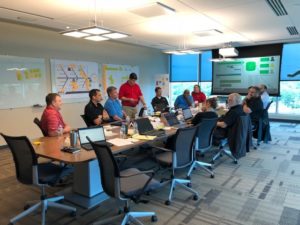10.23.2018
The Benefits of Interactive Planning
 Interactive Planning (IAP) means a lot of different things to a lot of different roles within an organization. As defined by Russell L. Ackoff, former Chairman of the Board of Directors for the Institute for Interactive Management, IAP focuses on creating the future by designing a desirable present. IAP is unlike other types of planning, such as reactive planning, inactive planning and preactive planning.
Interactive Planning (IAP) means a lot of different things to a lot of different roles within an organization. As defined by Russell L. Ackoff, former Chairman of the Board of Directors for the Institute for Interactive Management, IAP focuses on creating the future by designing a desirable present. IAP is unlike other types of planning, such as reactive planning, inactive planning and preactive planning.
In the past 30 years of my professional career, I’ve done all of these types of planning. Experience has shown me that the earlier you can engage in IAP, the better – whether for understanding root cause analysis, project planning, or in an effort to seek understanding and alignment with a team on virtually anything.
The following are considered by many as the top seven advantages to using interactive planning methodologies.
- Provides stakeholders the opportunity to create their own future.
- Considers all the subsystems of the organization to be part of the problem or solution.
- Promotes participation, which in turn enables all stakeholders to make a difference.
- Supports an environment of empowerment to influence work outcomes. Key stakeholders feel integral to getting the work done.
- Promotes creativity and demonstrates appreciation of out-of-the-box thinking.
- Facilitates ease of implementation, transparency and awareness of the project, removing apprehension and fear of the unknown.
- Finally, the IAP methodology is extremely flexible and applicable to a variety of purposes and applications. Consider it for internal and customer-facing projects, goal setting, project post-mortems, risk mitigation, and whatever else you can think of that a team is required to get done.
Regardless of its benefits, not everyone can facilitate a successful interactive planning session. An effective facilitator must possess excellent communication skills, a high degree of analytical skills, and considerable people skills. In addition, one must be able to:
- Understand group dynamics and the differences in personalities of individuals, and know how to use this knowledge to guide the group in a productive way. Think about your DISC/personality profile and those of the others in your IAP session.
- Establish an atmosphere in which the participants are willing to share their ideas and build on the ideas of others.
- Maintain the energy level and engagement of the participants and enable them to stay focused on the task.
- Connect their previous knowledge and experience to the current situation.
- Lastly, be creative. Creativity is manifested by expressing diverse thoughts to keep the session interesting and stimulating.
The next time you need to work through an issue, develop a plan, define a future state, or simply understand how to improve something, think about deploying an interactive planning methodology. There are many ways to conduct the sessions, and they can last anywhere from an hour up to multiple days. The key is to own it and make sure you keep the seven advantages and desired attributes of a facilitator in mind as you walk through developing your IAP session.
Here is a link to a PDF that was developed by the University of Pennsylvania “Scholarly Commons” as part of their MS in Organization Dynamics class study. This is a great place to start to understand how you can deploy the IAP methodology. Good luck!
If you enjoyed this blog article, please subscribe to stay up to date on the latest industry news from our experts at Faith Technologies.




